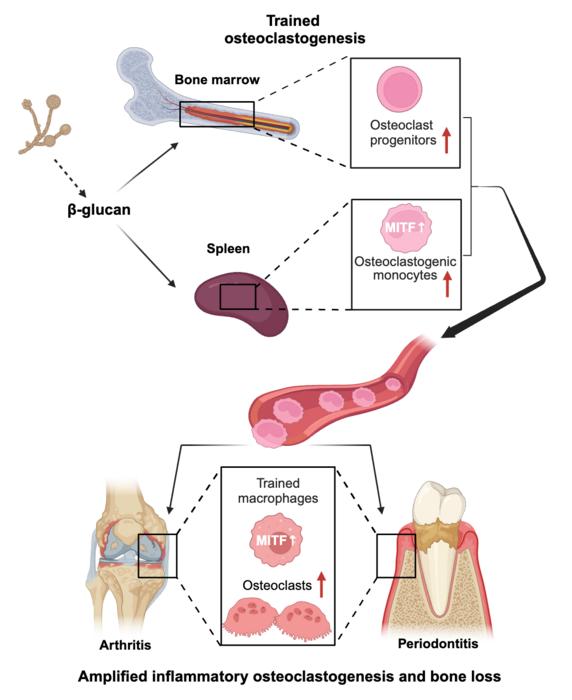
Recent studies have revealed profound insights into the innate immune system, challenging long-held beliefs regarding its capacity for memory and adaptability. Researchers at the University of Pennsylvania’s School of Dental Medicine, in collaboration with international experts, have examined the phenomenon known as “trained innate immunity” (TRIM) within the contexts of chronic inflammatory diseases such as periodontitis and arthritis. This groundbreaking work has important implications for understanding how innate immunity can lead to increased bone loss in these conditions, casting new light on the connection between the immune system and various bone loss disorders.
Historically, the adaptive immune system has received significant attention for its role in immunological memory, allowing the body to mount tailored responses against previously encountered pathogens. However, the innate immune system was long viewed as a primitive, non-adaptive branch of immunity, lacking the ability to “remember” past threats. Recent investigations over the last decade, however, have begun to dismantle this paradigm, revealing that innate immune responses can indeed be strengthened through previous exposures to various stimuli, akin to the memory function traditionally attributed to the adaptive immune system.
Central to this understanding is the role of certain compounds, like β-glucan, which is derived from fungi and shown to modulate the immune response. In experimental settings, researchers demonstrated that β-glucan induces TRIM, thereby priming osteoclast precursors in the bone marrow to differentiate into osteoclasts more readily. This differentiation process becomes particularly pronounced when an inflammatory challenge, such as arthritis, is introduced, suggesting that this trained immunity contributes to augmented bone resorption.
The implications of these findings are significant, particularly in the context of chronic inflammatory diseases. George Hajishengallis, a lead researcher on the study, emphasizes that while TRIM can confer protective effects against certain infections and tumors, it can concurrently exacerbate inflammatory responses and contribute to disease progress, particularly in conditions associated with bone loss. This duality indicates a complex interplay within the immune system that demands further investigation to truly harness its therapeutic potential.
Research indicates that the memory facilitated by TRIM can manifest in varying outcomes, either beneficial or detrimental depending on context. It has become increasingly clear that inflammatory responses, while naturally protective, can also become pathological when dysregulated. The investigation into TRIM’s role in bone metabolism challenges traditional views and opens avenues for tailored therapeutic strategies aimed at mitigating unwanted inflammatory effects while enhancing the immune system’s protective capabilities.
Furthermore, the findings suggest that it is not merely the initial exposure to a stimulus that determines the outcomes associated with TRIM, but rather the subsequent environmental factors and challenges faced by the immune system. This nuanced understanding shifts the focus from singular stimuli as drivers of immune responses to a broader consideration of the immunological context—highlighting how the innate immune system’s training can lead to increased susceptibility to diseases characterized by inflammatory processes, such as periodontitis and arthritis.
Hajishengallis and his team’s research offers critical insights into the mechanisms underlying TRIM and its effects on osteoclastogenesis, particularly demonstrating how β-glucan can heighten the response of osteoclasts during subsequent inflammatory challenges. While this training effect enhances the capacity of the immune response to deal with infections, it also underscores a risk factor for inflammatory bone loss in susceptible individuals. This reveals a critical paradox where immune training may be a double-edged sword; on one side lies enhanced protective mechanisms, while on the other, heightened reactivity can instigate or worsen existing inflammatory bone disorders.
The importance of these findings extends beyond theoretical discussions and into clinical application. For decades, cancer immunotherapy and vaccine development have predominantly revolved around enhancing the adaptive immune response. Now, the growing recognition of TRIM necessitates a reevaluation of the strategies implemented in treating autoimmune diseases and chronic inflammatory conditions. Harnessing the innate immune system through approaches designed to optimize TRIM could herald a new era in the management of inflammatory diseases, offering a potential pathway for interventions that can restore balance and function to dysregulated immune systems.
Future studies will need to delve deeper into the cellular and molecular mechanisms that define TRIM’s effects. Investigating the pathways linking β-glucan treatment with osteoclast differentiation could unveil novel targets for therapeutic intervention. Moreover, understanding how different stimuli modulate the innate immune response in various contexts may provide valuable insights into preventing or mitigating the adverse effects of chronic inflammation and bone loss.
Ultimately, the work conducted by Hajishengallis and Chavakis positions itself at the forefront of a paradigm shift in immunology. The insights garnered from this research challenge previously accepted doctrines about the innate immune system and point toward future avenues for exploration. As researchers continue to untangle the complexities of TRIM, the therapeutic prospects for patients suffering from inflammatory diseases could be significantly enhanced.
This groundbreaking research, set to be published in Developmental Cell, underscores the need for a comprehensive understanding of the immune system to develop effective therapeutic strategies against a myriad of diseases. As historical barriers between innate and adaptive immunity are dismantled, a new vision for the role of innate immunity in health and disease emerges—one that holds the potential to reshape the landscape of immunological science and clinical practice undeniably.
Subject of Research: Animals
Article Title: Innate immune training of osteoclastogenesis promotes inflammatory bone loss in mice
News Publication Date: 27-Feb-2025
Web References: https://www.dental.upenn.edu/, https://www.sciencedirect.com/science/article/pii/S1534580725000632
References: 10.1016/j.devcel.2025.02.001
Image Credits: Created with BioRender.com by George Hajishengallis and Triantafyllos Chavakis, 2025
Keywords: Innate immunity, osteoclastogenesis, chronic inflammation, inflammatory diseases, immune memory.
Tags: adaptive vs innate immunityarthritis and inflammationchronic inflammatory diseasesimmune responses and bone healthimmune system memoryimplications of immune modulationinflammatory bone disordersinnate immune trainingperiodontitis and bone losstrained innate immunityUniversity of Pennsylvania researchβ-glucan and immunity





